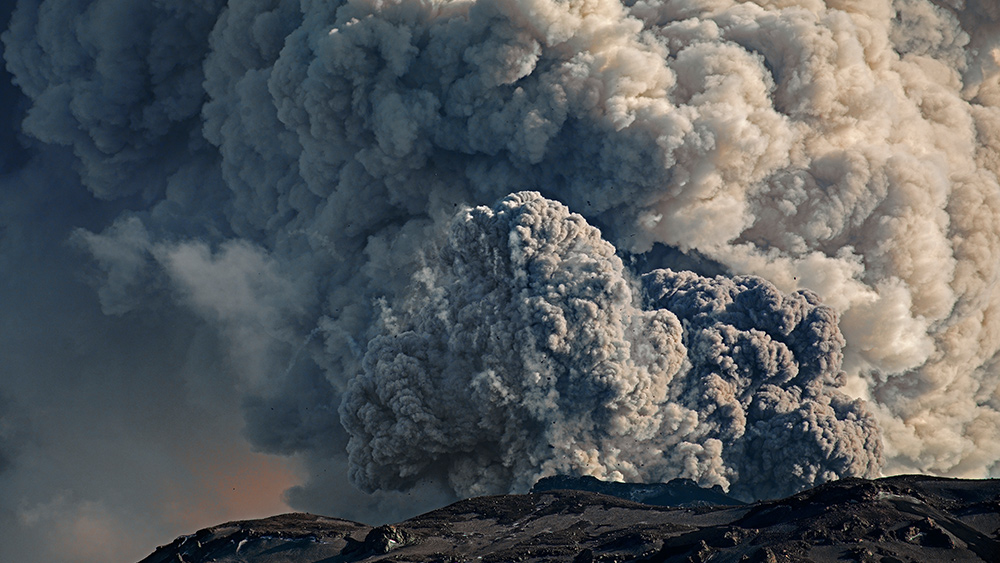Tonga volcano eruption produced mysterious, puzzling concentric ripples in the atmosphere
01/23/2022 / By Ethan Huff

Scientists are baffled over a strange series of ripples that were observed in Earth’s atmosphere following the recent eruption of the Tongan volcano.
Satellite imagery shows an unusual pattern of gravity waves that has not been seen in the past with volcanic eruptions. Could it be that some type of weaponry was involved to provoke the recent eruption in Tonga?
“It’s really unique,” commented Lars Hoffman, an atmospheric scientist at the Jülich Supercomputing Centre in Germany. “We have never seen anything like this in the data before.”
The discovery was made in images collected by the Atmospheric Infrared Sounder (AIRS), which is mounted on NASA’s Aqua satellite. It captured the waves in the hours after the eruption of the Hunga Tonga-Hunga Ha?apai volcano on January 14.
Dozens of concentric circles could be seen, each representing a fast-moving wave in atmospheric gases that stretched for more than 16,000 kilometers. These waves reached from the ocean’s surface all the way up to the ionosphere.
Reseachers also believe that these waves traveled around the globe several times before dissipating.
“This instrument has been operating for something like 20 years now and we have never seen such nice concentric wave patterns,” Hoffman added.
Were nuclear weapons involved with the Tongan volcano eruption?
Atmospheric gravity waves occur when air molecules in the atmosphere distribute vertically as opposed to horizontally. This can happen when wind picks up speed and rises over a mountaintop, for instance, or as a result of convection in local weather systems.
The up-and-down waves transfer energy and momentum through the atmosphere, often showing their effects as ripples in high clouds.
In the case of the Tongan volcano, it could be that the rapid updraft of hot air and ash from the eruption triggered these waves, though on a much larger scale. However, nothing like this has ever been observed with any previous eruptions ever since the AIRS instrument was launched in May 2002.
“That’s what’s really puzzling us,” added Corwin Wright, an atmospheric physicist at the University of Bath in the United Kingdom. “It must have something to do with the physics of what’s going on, but we don’t know what yet.”
The best that Wright and his coworkers have come up with so far is that a “great big, greasy pile of hot gases” in the upper atmosphere may have triggered these waves by “going up high into the stratosphere and knocking the air around.”
Another idea is that the atmosphere’s fundamental composition has been altered electrochemically in some way, possibly with geoengineering or “chemtrails.”
There is even chatter that perhaps the volcanos were triggered by some kind of nuclear detonation.
Whatever the case may be, the Tongan volcano eruption was loud, as people all around the South Pacific and even in some parts of the United States reported hearing extreme noises as it occurred.
“Ash has covered many regions of Tonga, but a loss of power, phone lines and Internet connectivity has made it difficult for aid agencies to assess the extent of injuries, fatalities and damage,” reported Strange Sounds.
Wright says that the images reveal what appears to be a mixture of wave sizes and types, and that the convection seen in the atmosphere was “very complicated and bumpy, and it’s generating a whole family of things at the same time.”
“That is what we currently think is going on, but we’ve only been looking at it for a few hours,” he added.
Another anomaly with the eruption was the explosive speed of the event, which occurred fully in about 10 minutes, “but it was explosive and it’s that impulse that is likely to kick off some strong gravity waves,” said climate scientist Scott Osprey.
Once again, does this point to a possible nuclear or other weaponized cause of the strange blast?
More related news stories can be found at Nuclear.news.
Sources for this article include:
Submit a correction >>
Tagged Under:
atmosphere, concentric ripples, eruption, explosion, gravity waves, Hunga Tonga-Hunga Ha?apai, Mother Nature, mysterious, natural disaster, puzzling, ripples, strange, Tonga, Unexplained, volcano, weird science
This article may contain statements that reflect the opinion of the author
RECENT NEWS & ARTICLES
COPYRIGHT © 2017 REAL SCIENCE NEWS





















